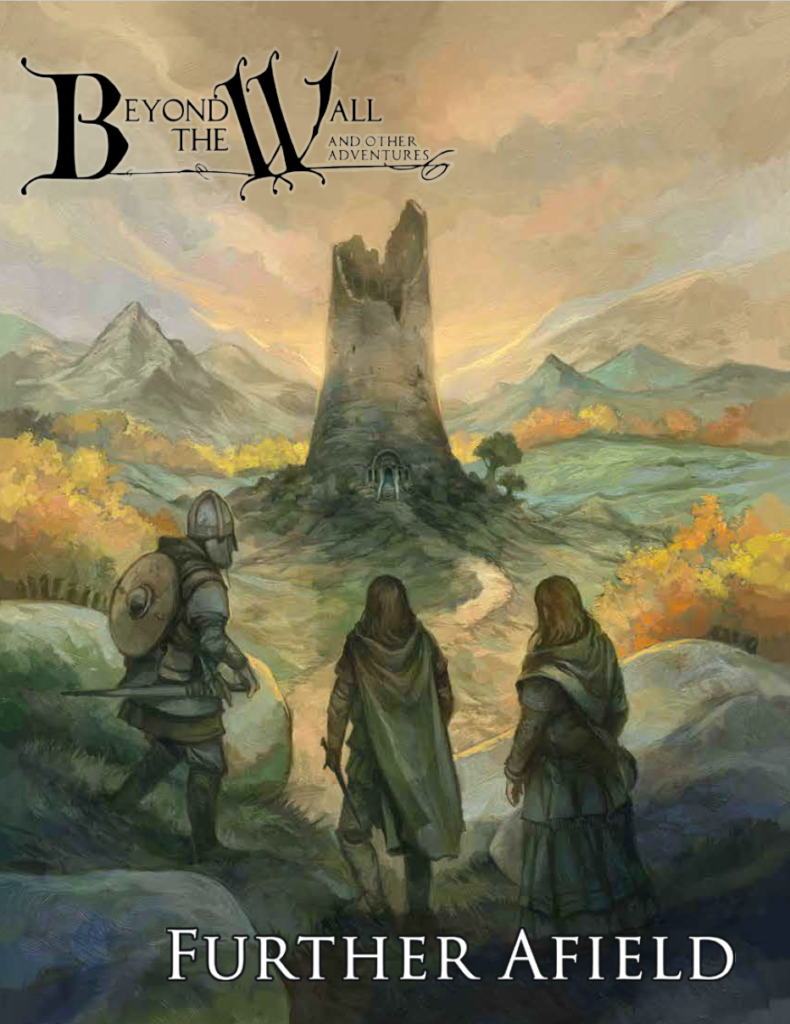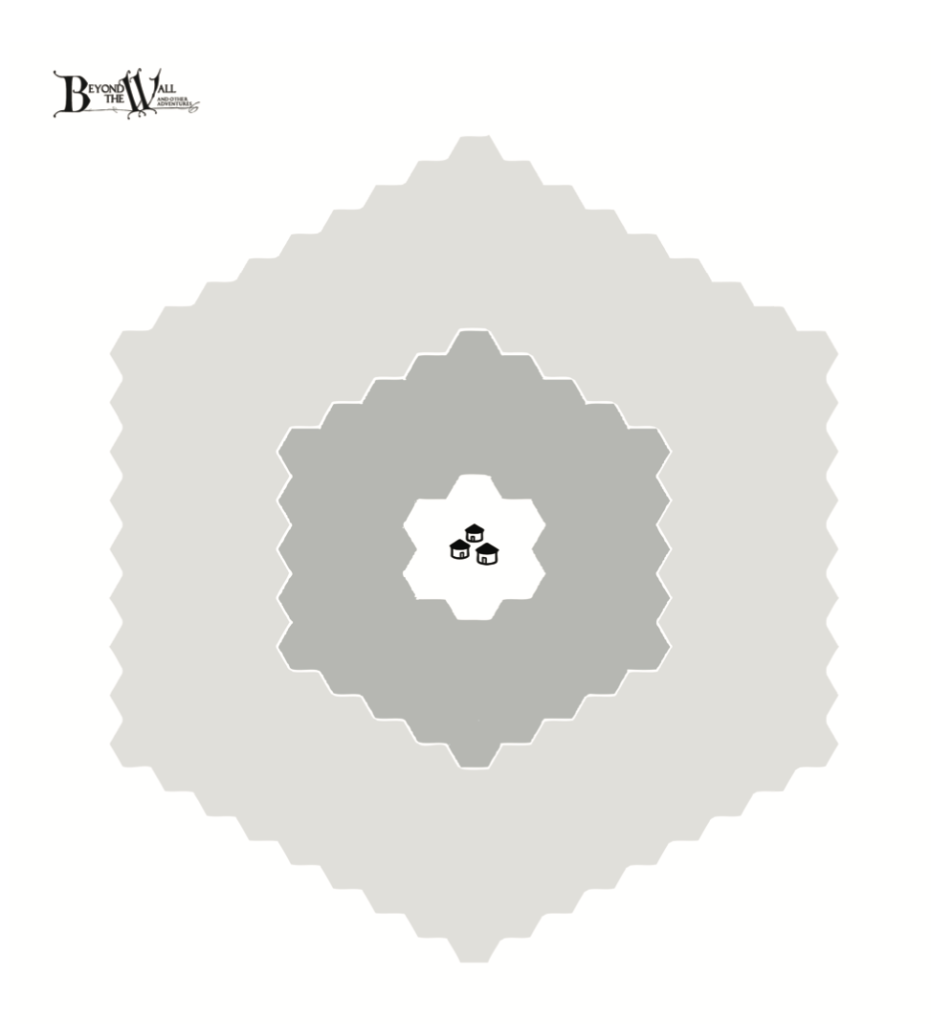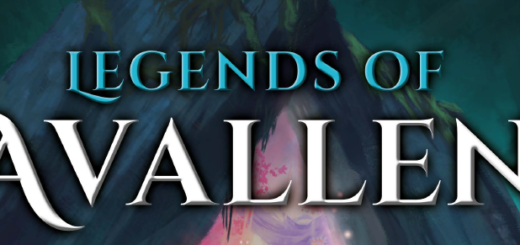Review of Beyond the Wall – Further Afield

For a few game sessions now, I’ve been running Beyond the Wall myself instead of just playing it. The characters haven’t gotten Further Afield yet, but it’s on the horizon. I have browsed Beyond the Wall – Further Afield before and had a rough idea of what was in it. However, this was the English edition. All the more pleasing when the reprint as a hardcover was due from my friends at System Matters. So when I was completing my Beyond the Wall collection, I also hit on the expansion volume for the wonderful Beyond the Wall.
I liked the core game and the principle of threats and locations already convinced me. They can also be found (in a modified form) in some of my publications in completely different systems as well. Since our last and so far only review of Beyond the Wall was a bit longer ago, and since we also published Beyond! the Mountainside Fortress which won the Fanzine Contest 2021 of System Matters, it is an obligation to write about Beyond the Wall – Further Afield.

- Publisher: Flatland Games
- Release: 2015
- Language: English
- Pages: 187
- Format: PDF / Print
- Price: 5.99 $ / 32.99 $ for the hardcover print / 32.99 $ for print and PDF on DriveThruRPG*
Further Afield!
In the expansion volume of Beyond the Wall, our heroines are not only drawn behind the walls of the village, but into the far distance. The goal is to explore the world and defeat threats to the village in the region in order to protect their home from harm. Beyond the Wall uses the hexcrawl for this, i.e. the creation of a hexagonal map for the region. This is filled with only a few locations, e.g. the village, and is therefore largely unexplored. The players as well as characters don’t know what is lurking in the region and have to discover it themselves.
Tips for Sandboxes and Hexcrawls
Like Beyond the Wall, Further Afield assumes that the players are not familiar with this type of game, a hexcrawl. So it is explained what a sandbox is and how a hexcrawl is created with the map, locations, encounters and secrets. Especially exciting are the approaches to create a sandbox together. With this approach, the players also create places in the region. To keep it mysterious, a test is required. This tells us how the heorine found out (seen, heard, learned) about this place. This leaves space for interpretation as the truth and the knowledge about this place could come from myths, tales or legends.

Locations
Beyond the Wall – Further Afield includes a campaign worksheet and divides the region around the village into three distance zones. In these you have to place the locations and terrain types. In terms of terrain types, we are talking about forests, mountains, meadows, rivers, etc. Everything that defines the type of terrain in more detail. Locations are special places with a story and possibly an adventure. They are definitely places that can and should be explored! With the locations there is the subdivision between minor locations and main locations. These differ basically in their size and weighting for the campaign. In a story where a dragon terrorizes the region, the dragon’s lair will be a main location and the farm of the Schmidt family will be a minor location.
In the book are sample regions for the typical regions like deserts, grasslands, woods etc. Those have a little description as in how those are different to each other and an encounter table. In addition there are two tables of “What type of location is this?” and “Who lives at this location?” to randomly determine a minor location.
Threats
For your own campaign there is the element of threat thanks to Beyond the Wall – Further Afield. The suggestion in the book is to choose one or two threats for your own campaign. Threats are the great calamity on the horizon. They are loose plots that operate in the region and, if ignored, will permanently alter or even destroy the environment of our heroines’ home. It is literally a threat to one’s own home village. As with creating your own village, threats provide a link to characters. Thus, each threat has a table that can be used. The new table will be used instead of another table during character creation, and should be used at least once. This creates a bond between the threat and the group of heroines.
However, it is also possible that new threats will develop organically in the campaign. For this, Beyond the Wall – Further Afield provides a small explanation as well as 4 example threats. These threats also provide examples so that you can create your own threats. Otherwise, you choose one of the 4 threats for your own campaign.
Imminence and Threat Effects
To make the threat act, the calendar is used. For this Further Afield provides a lunar calendar. But at its core, threats are about rolling the dice each in-game week. Since each threat has a imminence rating, it’s a matter of figuring out if we’re going to activate the threat’s effects.
To do this, the GM rolls a d12 every week and sees if the result is less than or equal to the imminence rate. If so, the dice are rolled on the threat effects table and the threat becomes active. The imminence rate can change over the course of the campaign and so can the chance of the threat becoming active. The situation is getting more serious! This is also the reason why one to two threats are recommended, otherwise the threats would rage every week. By the way, an alternative is to determine how likely it is that you will activate the threat based on the imminence rate and convert this to weeks. For example, with an imminence rating of 12, weekly; with an imminence rating of 8, rather every two weeks; and with an imminence rating of 4, rather every three weeks, etc.
Fighting the Threat
The group of young heroines will probably want to stop and defend against the respective threats in the course of the campaign. For this very reason, in addition to the background of the threat, special locations, threat effects, and possibly separate entries for special items, NPCs, beasts, and monsters, Threats also have a section on player actions. Under this section, it is explained what actions the players can take to counter the threat. Since this is a sandbox threat, these are more suggestions and ideas from the authors. The specific approaches are still up to the players. In the example of the vengeful dragon, open combat is not the only suggestion and possibility to remove the dragon from the region.
New Rules
Beyond the Wall also includes some new rules, spells, rituals and traits. Of course, in such a volume about exploring a land there will be a lot about equipment, provisions and travel in general. Still, I’d like to focus on some tools for the game master.
Death and new Characters
What happens when a player character dies? This is a question a GM will ask at some point in the course of a campaign or even a Few Shots if the system doesn’t a) address it or b) rule it out from the start. So what happens when this unfortunate state of affairs occurs? This question is not quite so simple to answer. Especially in Beyond the Wall, where character creation is an integral part of world-building at the outset.
Further Afield, however, has some nice ideas from the classic raising of an NPC or hireling to resurrection and its aftermath. And it’s nicely interwoven. Resurrection isn’t just this moment where a bright light shines down from the sky and magically-mysteriously breathes life back into the fallen person, but also draws consequences. These consequences are reflected in the threats of the campaign. Either the existing threats increase in their rate of disaster or a new threat rises.
Also very thematic is the introduction of Shadow Points as a counterpart to Fortune Points. The resurrected person receives 5 of these points and the party must spend all of them. Otherwise, the next level up the fallen person will have to return to the underworld. Shadow points, however, cause an automatic failure on a test and should therefore cause complications and be of importance.
Experience Revisited
The Beyond the Wall core rulebook rewards overcoming obstacles with experience points. This leads to the classic bookkeeping of old systems, where after every fight or other overcoming of a beast, it is looked at how many experience points this creature gives. Each person playing makes a note of the XP and it goes on. At the end you have an Excel spreadsheet and see if you move up a level.
While Further Afield doesn’t entirely solve this problem, there are alternative suggestions. It explains how many experience points a location should give. At the same time – and also quite classic – experience points for treasures and gold are introduced.
However, there is also the personal progression. Through milestones, characters can gain more experience points. Building a home, getting married and starting a family, founding a temple, hearing legends about yourself from faraway lands, becoming a knight, and much more. If you want it to be a bit easier, you can also take a simplified scheme, where there are fixed experience points after each session. There is also an explanation of how experience points are awarded for monsters for the game master and writers. This is a tool for creating your own creatures and breaks down how skills and hit dice lead to experience points.
Creating Magical Items
Beyond the Wall is fairytale-like. So are the magical items. Further Afield explains in a few pages what types of magical items there are and how they were created. A distinction is made between crafted items, items of deed that are blessed by a person’s heroic deeds, enchanted items where magicians have infused their powers.
It is explained for each of these types of items by means of short rules mechanics how this can take place. Items of deed can be created after a true heroic achievement, with the approval of the entire party and with the expenditure of a fortune point.
Conclusion
I feel Beyond the Wall is a nice introduction to the hobby. At the same time, I love the fairy tale theme and rather low-level magic of the world. For me, Beyond the Wall – Further Afield* provides a great bridge away from the single scenarios, which are super designed in themselves, but struggle to give us a picture of the world.
Further Afield provides the missing (and initially empty) map of the world around the heroine’s village. You don’t need Further Afield for that, you can draw your own map and connect the individual scenarios into a whole story. I, who likes a red thread in the story, get exactly that with Threats, Hexcrawl, Sandbox and its locations. I can go exploring with the group or set up a threat on the horizon and have it act, knowing the players should stand against it, but the path to get there is completely up to them.
GM-Tools
I’ve worked with a goal-based experience system in Dungeons and Dragons before in homebrew rounds. Most recently, I received feedback that this was exactly what drove and supported character motivations and definitions. This is exactly what I see in the optional rule of using milestones to distribute experience points. Founding an order of knights, building a trading post, and finding your great love, should be encouraged just as much as saving the village. In my eyes, these are people we embody with desires and feelings, not avatars of a video game.
As a writer of some works now soon, the table about the experience points is worth its weight in gold for me. I know how to apply experience points to a beast, what abilities are worth and what are not. For writing my own threat, not only the examples, but exactly this table helped me to equip the countless NPCs and creatures with values.
The locations themselves are great and offer a lot of good ideas for one or more evenings or a memorable place in your own world. They inspired me to create my own templates for locations in, for example, the german fanzine Beyond! the Mountainside Fortress and Tales from the Ironlands #2. Beyond the Wall again bridges the gap here for wrapping vaults or other locations into settings without getting too cluttered and bogged down in details. It’s about conveying the tone and feel of this world.








